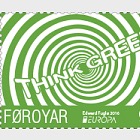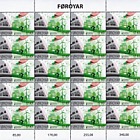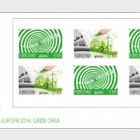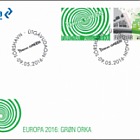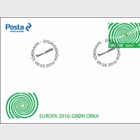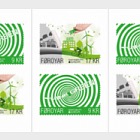- Home
- Stamps
- Faroe Islands
- 2016
Release years
2016Europa: Think Green - Set
- 09.05.2016
- Edward Fuglø and Doxias Sergidou
- -
- Oesd, Austria
- Offset
- 4 Colours
- 40 x 26,5 mm
- 9 and 17 DKK
Europa 2016: Think green
Renewable energy is on everyone's mind these days. There are definite limits to the earth's fossil fuel resources. Oil and coal-fired power plants are contributing excessively to the total CO2 emissions, already affecting the global climate to such an extent that we now are able to physically measure the negative consequences. Then there is the unsettling conclusion of Murphy's Law stating that "anything that can go wrong, will go wrong" – something that repeatedly has been confirmed by the otherwise efficient nuclear power plants.
In the Faroe Islands it was the topography of the country, the steep mountain sides and the vast amounts of rain, which from the very beginning spurred the interest in renewable energy.
The pioneer
Already back in 1907, Ólavur á Heygum, a farmer and a businessman, attempted to have a hydroelectric plant built in his hometown of Vestmanna. He had an idea of stemming the precipitous river Fossá, conducting the water down to a turbine located on the shore. Ólavur started a simple damming of the river, but lack of interest and funding meant that the project had to be abandoned. Until his dying day in 1923 Ólavur tried to win support for his plans, but political bickering and personal bankruptcy due to his idealistic undertakings, put an effective end to his pioneering efforts.
In Botn
Instead, it was due to efforts by insightful local businessmen and the municipal council in Vágur in Suðuroy that the first hydroelectric plant in the Faroes was built. By damming up two mountain lakes in the mountains north of the village and conducting the water in pipes down to the turbines at the base of the steep valley "in Botn" on the west coast, an efficient power plant eventually started producing electricity for the entire island. The hydropower plant was commissioned in 1921 and is still operative.
In the same year that the hydroelectric power plant "in Botn" started producing electricity, an engine power plant was commissioned in Torshavn, where topographic conditions for hydroelectric plants are non-existent. In 1931 a hydroelectric power plant started operating "Norðuri á Strond", close to the booming fishing town of Klaksvík on Borðoy island. In the years that followed small and major water and engine power plants began operation in various locations – but it was not until after the Second World War that efforts were made to coordinate an effective production of electric power.
SEV
In 1946 19 municipalities in the centrally located islands of Streymoy, Eysturoy and Vágar, founded a public electric production company named SEV. The company was tasked to coordinate and fund a joint effort in electric power production and in 1951 a large-scale project was initiated with the aim of realizing Ólavur á Heygum's vision of a hydropower plant in Vestmanna. Dams were built in mountain creeks and the water was channelled in pipes down to a power station on the banks of the river Fossá. On May 5th 1954, the Fossá power plant became operative. In a period of nine years following the Fossá project, two more hydroelectric plants were built at Vestmanna.
In 1963 power production capacities across the country were transferred to SEV, power producer and distributor. Consequently SEV assumed control over the local hydro- and engine plants. The distribution network was streamlined and smaller engine power plants around the islands were taken out of service.
Throughout the sixties energy needs in the Faroes increased constantly, especially in the central regions. It was therefore decided to build a power plant operating on crude oil in the Sund region north of Tórshavn. In 1975, two large machines in the Sund power plant became operative. The plant was further expanded in the late seventies and early eighties and now comprises five machines. Functioning mainly as a backup the Sund power plant is capable of supplying the entire Faroe Islands with electric power if, for some reason, the rest of the plants should become inoperative.
The Eiði Hydropower Plant
The Sund power plant turned out to be an expensive affair even before it was finished. The oil crises in the early and late seventies opened the eyes of the decision-makers to the fact that renewable energy was the way forward. A decision was made to further expand hydropower plants - this time exploiting major water resources in a mountain lake called Eiðisvatn, south of the village of Eiði in Eysturoy.
The project called for the construction of a power plant and dam to increase the capacity of Eiðisvatn. In addition, tunnels were drilled in several phases to rivers in the area. The first turbine in the Eiði power plant became operative in 1987, and in 2014 the power plant was finally finished with the installation of three powerful turbines.
Wind power
Already back in the seventies private experiments were made with wind power in the Faroe Islands. As strange as it sounds, wind power poses an array of complex predicaments in the islands where there otherwise is no shortage of wind. The problem consists in the constantly changing wind speed - from gentle breezes to winds of hurricane strength, combined with violent gusts of wind caused by the rugged topography of the land. This calls for robust wind turbines and levelling techniques to match the surroundings.
In 1993 SEV erected a wind turbine in Neshagi in the south of Eysturoy. In 2003 the company made an agreement with the privately owned company "Røkt" to buy electric power from the company's three wind turbines at Vestmanna.
Two years later, in 2005, SEV erected three more wind turbines in Neshagi on a trial basis. These turbines were huge and could be seen from far and wide - immediately earning the place the colloquial nickname "Calvary". During a hurricane at the turn of 2011/12, two of these mills were destroyed. The third one was taken down, and in 2012 two new wind turbines were erected at the site, as well as three more, further south in the area. These new turbines are equipped with features that can withstand very high winds and produce energy in wind forces reaching up to 34 meters per second.
In 2014 the wind energy sector gained additional capacity when SEV’s Húsahagi wind farm came officially online with 13 large wind turbines. Experiments are also made with battery capacities designed to reduce irregularities in wind energy supply. Technological progress has led to a greater yield of wind energy in the total energy production.
In 2015 renewable energy sources, hydro- and wind power, constituted 60% of the total energy production in the Faroe Islands - while the remaining 40% is based on fossil fuels. A 2014 study of energy production countries revealed that of all countries which do not have natural energy sources (as for example Iceland with its hot springs), Denmark was at the top of the list with a green energy production of 40%, followed by Germany with approximately 30%. That same year the Faroe Islands, which were not included in the study, had a hydro- and wind power production of 51%, which is significantly higher than that of Denmark and Germany. In just one year, an additional 10% was added to the production.
According to power producer SEV, the goal is that renewable energy production will reach 100% in 2030.
Anker Eli Petersen
WOPA+ recommended stamp issues
| Music Giants VII - Iron Maiden |
| Issued: 12.01.2023 |
| ›Great Britain |
| Effigy of H.S.H Prince Albert II - Green Letter Rate |
| Issued: 03.01.2023 |
| ›Monaco |
| Year of the Rabbit |
| Issued: 05.01.2023 |
| ›Guernsey |
| Dimitrie Cantemir, 350th Anniversary of his Birth |
| Issued: 16.01.2023 |
| ›Romania |
| Medicinal Plants |
| Issued: 03.01.2023 |
| ›Romania |
| Lunar New Year - Year of the Rabbit |
| Issued: 05.01.2023 |
| ›Jersey |
| Honour Guard of the President of the Slovak Republic |
| Issued: 02.01.2023 |
| ›Slovakia |
| Veteran Tractors |
| Issued: 04.01.2023 |
| ›Aland Islands |
| St. Elizabeth’s Church in Parnu |
| Issued: 06.01.2023 |
| ›Estonia |



